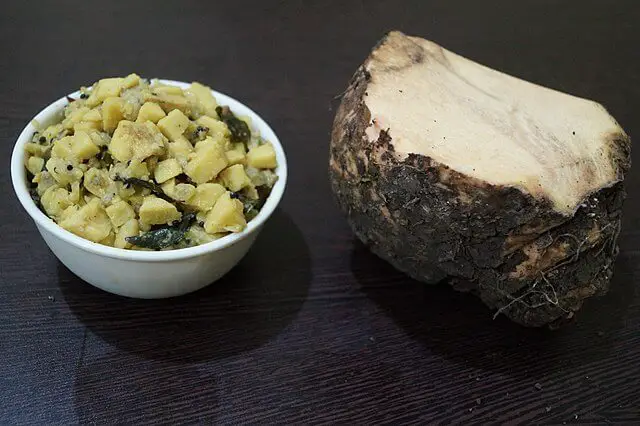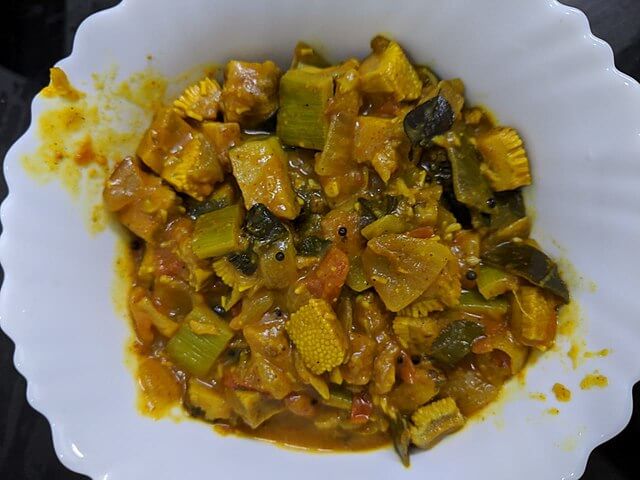The Elephant Foot Yam vegetable is a very unique vegetable, and probably one you haven’t heard of if you don’t live in Southeast Asia. It’s also called is also called Jimikand, Elephant Yam, Indian Yam or Suran.

It gets its name from the fact that it looks like an elephant’s foot and has a hard outside. It’s a very nutritious vegetable and can even be used as a substitute for meat on a plant-based diet. The Suran vegetable has even been used for medicinal purposes.
The Elephant Foot Yam plant is grown in Southeast Asia and the Pacific Islands as a cash crop for profit, as well as in Africa in Madagascar. The Elephant Foot Yam is also called Suran or Ol and is found in Indian dishes. It can also be known as whitespot giant arum. Elephant Foot Yam is used in foods in these regions, where it is more well known. Living in the United States, I had never heard of it before. The Elephant Yam in the USA is pretty uncommon.
Different names for Elephant Yam include:
- Jimikand
- Suran
- Ol
- Indian Yam
- Elephant Yam
- White spot giant arum
- Cheeky Yam
- Chena Yam
- Karunai Kizhangu plant or karunai kilangu
- Senai Kilangu plant or Senai Kizhangu plant
- Amorphophallus paeoniifolius is the Scientific Name
The Elephant Foot Yam has high nutritional value and health benefits. It comes from the Amorphophallus paeoniifolius plant. The Elephant Yam’s flower is sometimes called stinky lily, because of the order it gives off after it has bloomed.
The Elephant Yam is a tuber or root vegetable and it is commonly mashed or fried and added to curries. It can also be fried to make chips. Also, the Suran vegetable stems and leaves are sometimes fried and eaten as well. In the Philippines, the Jimikand is known as pongapong and the leaves and stems are eaten as well.
The Elephant Foot Yam in Tamil is known as the Senai Kilangu plant or the Senai Kizhangu plant.
Elephant Foot Yams can be packed with nutrition. Let’s look at some of the Elephant Foot Yam benefits below.
You can check out 13 Things to Know About Elephant Foot Yam (Suran, Jimikand, Elephant Yam) for commonly asked questions and more things to know.
Elephant Foot Yam Benefits
Is the Elephant Foot vegetable good for health? Yes, the Jimikand has tons of benefits related to health. Indian Yam has been used for many medicinal purposes in different cultures. Even the British pharma industry sought it and other yams for diosgenin, used to make Cortisone and other products.
Let’s look at some of the Elephant Yam benefits below, they include:
- Cheap source of carbohydrates. The Elephant Foot Yam is a staple in many cultures and provides a lot of nutrition and a plant-based food at a cheap cost. The Elephant Foot Yam also contains some protein.
- Contains vitamins and minerals
- Provides magnesium, potassium, zinc, calcium, phosphorous and selenium
- Provides antioxidants
- High in fiber
- Helps with weight loss due to high fiber content
- Helps with digestive issues such as constipation and cramps. Sometimes Elephant Foot Yam is used in laxatives.
- Very sustainable and grows very easily, even in harsh conditions
- Reduces bad cholesterol (LDL) due to phytosterols and is a heart-healthy food
- Raises good cholesterol levels
- Helps with hormones in females. Boosts estrogen production and contains B6 to help with menopause.
- Reduces blood pressure and hypertension
- Helps blood flow by reducing vein blockage
- Anti-coagulant and may help prevent heart attacks and stroke
- Increases red blood cell production
- Improves the immune system
- Reduces inflammation
- Anti-aging
- Detoxifies the body including the liver, stomach and intestines.
- Used in India to treat tumors, arthritis, fatigue and more.
- Helps with memory
- High fiber content helps to prevent colon cancer
- Good for the skin. The antioxidants help to promote skin health.
- Used in the treatment of hemorrhoids due to helping with constipation.
- Anti-bacterial
- Elephant Foot Yam seeds can be crushed to relieve toothache.
The Indian Yam has tons of benefits. It has even been used in traditional Ayurvedic medicine for many uses. (You can learn more about the benefits at Elephant Foot Yam Health Benefits)
Elephant Foot Yam Nutrition
Elephant Foot Yam’s nutrition content is about the same as regular yams and sweet potatoes. It is high in good carbohydrates and fiber and also contains some protein. It also contains lots of vitamin A as well as some vitamin C, potassium, magnesium and calcium.

A 130G serving size contains 25 grams of carbs, 2 grams of protein and 2 grams of fiber. This ends up being 110 calories. It also has a low GI or Glycemic Index level and does not raise blood sugar very much. Its GI level is lower than that of potatoes.
It’s been found to contain antioxidants like oxalates, cyanide, tannins, and phytates.
See Elephant Foot Yam Nutrition for more.
Is Elephant Foot Yam Poisonous?
Even though the Suran is associated with itching in the mouth and throat, it is not poisonous and is safe to eat as a food or medicine. It is the high amount of raphides present that causes this sensation. This is experienced if eaten raw or if the Elephant Yam is not cooked enough.
Is Elephant Foot Yam Good for Diabetes?
Elephant Foot Yam has been found to be good for patients with diabetes. A study found the Suran vegetable to be both safe and beneficial. Also, it has a low Glycemic Index level, and is lower than regular potatoes.
Elephant Foot Yam in USA
It can be very hard to find Elephant Yam in the U.S. This is especially true for the fresh Suran. Some have been able to find it in the frozen vegetable section of the supermarket with other Indian food.
Elephant Foot Yam Recipes
The Indian Yam needs to be cooked before eating, and can be used in place of potatoes or root vegetables. It can replace them in main dishes or Elephant Yam can be served as a side. It can also be cut thin and fried just like chips and even eaten as a snack.
The Suran vegetable is also used in India commonly as a meat substitute. This is great since a Plant-based diet is the healthiest way to eat.
Just like potatoes, the Jimikand or Suran can be baked or mashed. Suran tastes very much like yams or sweet potatoes without the sweetness. It has a very neutral flavor in cooking and just like potatoes, it takes on the flavor of the dish it is added to. Indian Yam is sometimes pickled in certain regions. Also, it is sometimes used to make a flour that is gluten-free.
Here are some Indian Yam recipes and ideas for Elephant Foot Food that can be eaten.
- Elephant Foot Yam Recipe – Karunai Kilangu Shallow Fry
- How to Make Elephant Foot Curry in Andhra Style
- Suran Chips
- Suran Spicy Curry (Indian Yam Spicy Curry)
- Jimikand ki Sabzi Recipe
- Jimikand Curry Recipe – Indian Yam Recipe
Elephant Foot Yam Final Thoughts
The Elephant Yam has so many great benefits, and it can be seen why it was used in traditional medicine. Also, it is a very healthy food, and so it made the list of Vegetables That Start With E as well as Top 17 Foods that Start with E – Healthy & Beneficial.
It’s known by many different names such as the Jimikand, Elephant Yam, Indian Yam, and Suran. It has many applications in cooking and can be cooked just as potatoes are or used as a meat substitute.
You can find Things to Know About Elephant Foot Yam & Common Questions to find more info about this extremely nutritious vegetable.
Video Resources:
ELEPHANT FOOT YAM Cooking | Elephant Foot Yam Fry and Gravy
Elephant Foot Yam & Mutton Biryani Recipe
Amorphophallus paeoniifolius” Elephant’s Foot Yam
Lance has been passionate about the plant-based diet and we have been following a whole food plant-based diet for over 5 years. We focus on health, natural healing, weight management, animal rights, and the health of the planet and environment by focusing on whole plant-based foods and sustainable practices.
Learn more at the About Me page and follow on social media at the links below.






